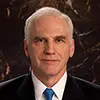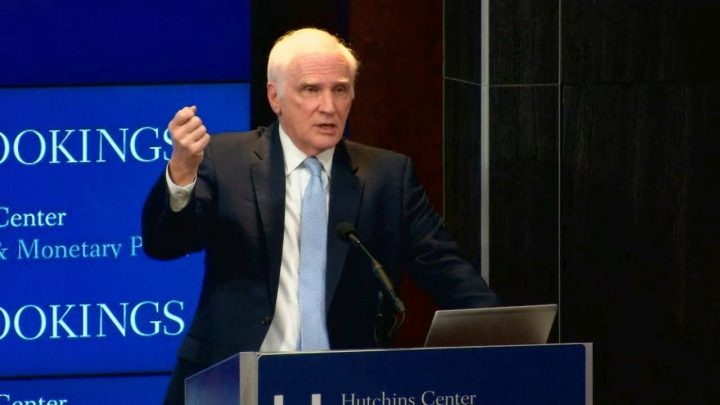These remarks were given at the public event, The repo market disruption: What happened, why, and should something be done about it?, presented by the Hutchins Center on Fiscal & Monetary Policy at Brookings on December 5, 2019.
In his remarks, Dan Tarullo, former member of the Federal Reserve Board and the Federal Open Market Committee, introduced the questions we need to ask in light of the September repo market disruption. Before doing so, he briefly noted changes in relevant circumstances prior to September that should inform discussion of those issues: 1) changes in the Fed balance sheet; 2) changes over the last couple of years in the Treasury market; and 3) changes in the prudential regulation.
Tarullo touched upon the following issues in light of the recent repo price spike:
1. Fed balance Sheet Policy Issues
Most immediately, will there be another reserve shortage and price spike at the end of the year? The Fed will be only partway through its renewed purchase program, and end-of-year balance sheet window dressing by some banks may further constrict their capacity or willingness to increase their repo market activity. Tarullo presumed that the Fed is now just as focused on this possibility as markets are, and will be prepared to augment reserves as needed toward the end of this month. The more interesting issue is what recent experience implies for balance sheet policies over the longer term.
The second question is what set of balance sheet policies the Fed should adopt given its volatility tolerance. In its October Statement the Fed noted its intention to continue balance sheet growth as non-reserve liabilities grow, so as to maintain reserves at about the level that prevailed prior to the September incident. Is this intended size for a buffer adequate? The answer must depend in part on whether the Fed is reasonably confident in predicting the effective capacity of banks to respond to spikes in demand for repo.
An additional question relates to the impact of the Fed’s foreign repo pool in taking up balance sheet space. This issue introduces a whole additional set of considerations, including whether the dollar’s central international role argues for the Fed to depart from the practice of other central banks operating similar facilities, such as a cap on its size.
2. Financial Regulation Issues
As has been the case with their response to many financial developments, representatives of the banking industry were quick to suggest that the September experience had been caused by excessive bank regulation, that the right response was in any case one or more forms of deregulation beyond those already in process, or both. Tarullo commented that at the outset, all the regulations being blamed for the price spike were in place for at least several years beforehand. Yet until a few months ago, while there were a few hints of possible problems as the Fed began to reduce its balance sheet, there had not been any repo disruptions. Second, might it not be better regulatory policy to calculate most metrics for the surcharge formula, including repo activity, based on averages over the course of the preceding year, rather than on a point-in-time (or four points-in-time) basis? This would both accommodate temporary increases in some bank activity even at the end of the year, while precluding the window dressing exercise by which a bank that has engaged in higher levels of that activity artificially slims down for a quarterly or annual snapshot of its balance sheet. Third, though, the window dressing exercise that can involve year-end reductions in repo activity reflects the cliff-effect disadvantage of the bucket approach to surcharges, as adopted by the Financial Stability Board following the financial crisis.
The issues raised by the repo disruption with respect to regulations affecting the composition of bank balance sheets are, Tarullo noted, more difficult. As nearly everyone immediately recognized, the Liquidity Coverage Ratio was essentially irrelevant in September, since Treasuries and central bank reserves are treated identically. The reason for discriminating between Treasuries and reserves is that the former need to be monetized. In stressed circumstances, when liquidity providers generally become more cautious even as borrowers need more funding, monetization through other market actors may not be immediately possible. Thus, if the aim of resolution planning and liquidity requirements is to assure funding self-sufficiency by banks under all circumstances, there will be a preference for reserves.
In closing, Tarullo suggested one related, but much broader regulatory issue that was implicated by the repo episode. The post-crisis approach to liquidity regulation – and here the Liquidity Coverage Ratio is relevant – requires banks to amass large quantities of liquid assets to ensure their self-sufficiency during periods of stress. Tarullo commented that questions about the theoretical foundations for the current approach to liquidity regulation have been further complicated by the torrent of new Treasury issuance and the reduction in the size of the Fed’s balance sheet. Yet it’s neither realistic nor desirable to delay decisions on the more immediate issues surrounding Fed balance sheet policies. Devising a different approach to liquidity regulation – perhaps one centered on sustainable funding practices rather than pools of liquidity – would take time, especially since any significant change would need to be coordinated internationally. And if an element of a different approach were to include liquidity assistance, such as a Fed facility that would stand ready to monetize Treasuries or other assets, the possible resulting increase in moral hazard would need to be addressed. But the disruption in repo markets, along with recent reports of serious potential funding vulnerabilities among non-banks involved in mortgage lending, together remind us that liquidity regulation remains an important unfinished piece of post-crisis regulatory reform.
The Brookings Institution is committed to quality, independence, and impact.
We are supported by a diverse array of funders. In line with our values and policies, each Brookings publication represents the sole views of its author(s).




